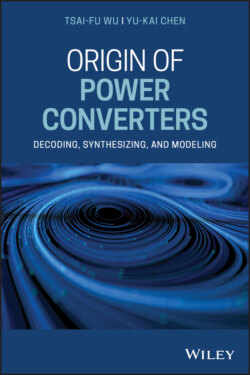Читать книгу Origin of Power Converters - Tsai-Fu Wu - Страница 17
1.2.1 Non‐PWM Converters
ОглавлениеThe major concern of a power converter is its input–output conversion efficiency. In practice, there is no resistor allowed in a converter configuration. A qualified converter includes only ideal switch(es) and capacitor(s)/inductor(s). However, even with these components only, there might still exist loss during power transfer, such as the converters shown in Figure 1.5a and b. Figure 1.5a shows power transfer between two capacitors, and it is controlled by switch S1. Assuming capacitor C1 is associated with an initial voltage of Vo and C2 is with zero voltage, and capacitance C1 = C2, it can be shown that there is an electrical energy loss, , which is half the initially stored energy in C1. Moreover, when switch S1 is turned on, an inrush current flows from C1 to C2 and through S1 in almost no time, which may damage the components and cause EMI problems. For this type of circuit configuration, the only current limiter is the equivalent inductance and resistance of the components and the circuit path. It can be said that there is no control on the capacitor currents and voltages, and the voltages of both capacitors C1 and C2 will be always balanced at (1/2)Vo. This type of power converter configuration is classified as a non‐PWM converter.
Similarly, the conceptual inductor–inductor–switch configuration shown in Figure 1.5b has the same limitations. If, initially, inductor L1 carries a current of Io but there is no current in L2, after turning on switch S1, there will be an extremely high impulse voltage across the inductors and the switch, causing EMI problems and damage to the components. Again, there is half electrical energy loss if L1 = L2, and there is no control on the inductor voltages and currents at all. It is also a non‐PWM converter.
Figure 1.5 (a) Capacitor–capacitor–switch, (b) inductor–inductor–switch, and (c) capacitor–inductor–switch networks.
In summary, non‐PWM converters come out high inrush current or high impulse voltage, resulting in high EMI, as well as high component stress, and they could yield low conversion efficiency even with ideal components. In particular, under large initial voltage difference, the maximum electrical energy loss can be as high as 50%.
Other examples adopting the configuration shown in Figure 1.5a are shown in Figure 1.6. Figure 1.6a shows a two‐lift converter. When switches S1 and S2 are turned on, capacitor C1 will charge C2 directly. On the other hand, when switch S3 and S4 are turned on, capacitors C1 and C2 are connected in series to charge capacitor C3 and lift the output voltage Vo to be twice the input voltage Vi. It can be seen that during capacitor charging, there is no current limiter, resulting in high inrush current. Figure 1.6b shows the KY converter. When switch S2 is turned on, input voltage Vi will charge capacitor C1 through diode D1 but again without current limiter. When switch S2 is turned off and S1 is turned on, input voltage Vi together with capacitor voltage VC will magnetize inductor L1 through the output path. This path of power flow is with the current limiter of inductor L1. Figure 1.6c shows a re‐lift converter. When switch S1 is turned on, there are two capacitor charging paths without current limiter, Vi‐S1‐D2‐C3‐D3‐Vi and Vi‐S1‐D21‐C12‐D11‐Vi. When switch S1 is turned off, the energy stored in capacitors C3 and C12 will be released to the output through the inductors and capacitors, which are the current limiters.
Figure 1.6 Non‐PWM converters: (a) two lift, (b) KY, and (c) re‐lift circuit.
With a non‐PWM converter, the processed power level is usually pretty low because of high inrush current or high pulse voltage. It can be used for supplying integrated circuits, which require low power consumption, of which the low current rating switches have high conduction resistance and act as current limiters. For high power processing, we need PWM power converters.
